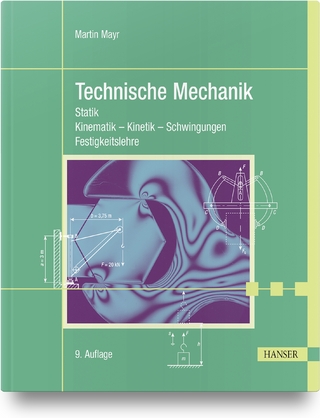
Mechanical Behaviour of Engineering Materials
Springer-Verlag New York Inc.
978-1-4020-0350-9 (ISBN)
, Addison Wesley Longman (Pearson Education), American Chemical Society, American Institute of Physics, Archives of Mechanics / EngineeringTransactions (arch;wum mechaniki stosowanej/ rozprawy inzynierskie, Warsaw, Poland), BritishTextileTechnology Group, Butterworth-Heinemann Ltd. (USA), Chapman & Hall Ltd. (International Thomson Publishing Services Ltd. ), Elsevier Science-NL (The Netherlands), Elsevier Science Limited (UK), Elsevier Sequoia S. A. (Switzerland), John Wiley & Sons, Inc. , lOP Publishing Limited (UK), Kluwer Academic Publishers (The Netherlands), Les Editions de Physique Les Ulis (France), Pergamon Press Ltd. (U. S. A), Society for Experimental Mechanics, Inc. (USA), Springer-Verlag (Heidelberg, Germany), Steinkopff Verlag Darmstadt, Tappi, Technomic Publishing Co. , Inc. (U. SA) and The InstituteofPhysics (UK).
9 Transition to the Dynamic Behaviour of Engineering Materials.- 9.1 Introduction.- 9.2 Response Behaviour of Metals under Dynamic Loading.- 9.3 Metallurgical Effects.- 9.4 References.- 9.5 Further reading.- 10 Plastic Instability and Localization Effects.- 10.1 Introduction.- 10.2 Onset of Shear Banding.- 10.3 Strain-Rate and Temperature Effects.- 10.4 Bifurcation Analysis for Specific Constitutive Equations.- 10.5 Post-bifurcation Analysis.- 10.6 Plastic Instabilities in Specific Problems.- 10.7 Instability Propagation (Metallic and Polymeric Materials).- 10.8 Flow Localization of Thermo-Elasto-Viscoplastic Solids.- 10.9 Effect of Material Rate History.- 10.10 Three-Dimensional Effects.- 10.11 Problems.- 10.12 References.- 11 Elastic Wave Propagation.- 11.1 Introduction.- 11.2 Elastic vs. Inelastic Waves.- 11.3 Elastic Wave Propagation.- 11.4 Reflection and Refraction of Waves at a Plane Interface.- 11.5 Wave Propagation in Bounded Elastic Solids.- 11.5.9. Stress waves in plates.- 11.6 Study Problems.- 11.7 Problems.- 11.8 References.- 11.9 Further Reading.- 12 Dynamic Plastic Behaviour.- 12.1 Introduction.- 12.2 The Dynamic Plasticity Problem.- 12.3 Dependence of the Wave Equation and its Characteristics on the Response Behaviour of the Material.- 12.4 The Problem ofInstantaneous Impact.- 12.5 Determination of the LoadinglUnloading Boundary.- 12.6 Plastic Shock Wave.- 12.8 Transition to Dynamic Thermoplasticity.- 12.9 References.- 12.10 Further Reading.- 13 Characterization of Linear Viscoelastic Response Using a Dynamic System Approach.- 13. 1 Introduction.- 13.2 Dynamic System Identification Methods.- 13.3 Discrete-time System Analysis as Based on the Time-rate of the Input Signal.- 13.4 Extension of the Model to Include the Instantaneous Response Behaviour.- 13.5References.- 13.6 Further Reading.- 14 Viscoelastic Waves and Boundary Value Problem.- 14.1 Introduction.- 14.2 Internal Friction and Dissipation.- 14.3 Viscoelastic Wave Motion.- 14.4 Wave Propagation in Semi-Infinite Media.- 14.5 The Wave Equation in Linear Viscoelasticity as Based on Boltzmann’s Superposition Principle.- 14.6 The Wave Propagation Problem as Based on the Correspondence Principle.- 14.7 Nonlinear Viscoelastic Wave Propagation.- 14.8 Acceleration Waves.- 14.9 Shock Waves.- 14.10 Thermodynamic Influences.- 14.11 Study Problems.- 14.12 Transition to the Viscoelastic Boundary Value Problem.- 14.13 Study Problems.- 14.14 References.- 14.15 Further Reading.- 15 Transition to the dynamic behaviour of structured and heterogeneous materials.- 15.1 Introduction.- 15.2 Influences of Material Properties on Dynamic Behaviour.- 15.3 “Discontinuous” vs. “Continuous” Fibre-Reinforcement.- 15.4 Sheet Molding Compounds (SMC).- 15.5 The Trade-off between Damping and Stifthess in the Design of Discontinuous Fibre-Reinforced Composites.- 15.6 Study Problems.- 15.7 References.- 15.8 Further Reading.- 16 The Stochastic Micromechanical Approach to the Response Behaviour of Engineering Materials.- 16.1 Introduction.- 16.2 Probabilistic Micromechanical Response.- 16.3 The Stochastic Micromechanical Approach to the Response Behaviour of Polycrystalline Solids.- 16.4 References.- 16.5 Further Reading.- 17 Intelligent Materials - An Overview.- 17.1 Introduction.- 17.2 Definition ofan Intelligent Material.- 17.3 The Concept ofIntelligence in Engineering Materials.- 17.4 Artificial Intelligence in Materials.- 17.5 Optical Fibres as Sensors.- 17.6 Shape Memory Alloys (SMA).- 17.7 Shape Memory Polymers.- 17.8 Electro-Rheological Fluids.- 17.9 References.- 18 PatternRecognition and Classification Methodology for the Characterization of Material Response States.- 18.1 Introduction.- 18.2 The Acousto-Ultrasonics Technique.- 18.3 Fundamentals of the Design of Pattern-Recognition (PR) Systems.- 18.4 Illustrative Applications.- 18.5 Design and Testing ofa Pattern Recognition System.- 18.6 References.- 18.7 Further Reading.- Appendix D The z-Transform.- D.1 Introduction.- D.2 Properties of the z-Transform.- D.3 Relations between the z-Transform and Fourier Transform.- Examples.- D.4 Regions of Convergence for the z-Transform.- D.5 The Inverse z-Transform.- D.6 Problems.- D.7 References.- D.8 Further Reading.- Cumulative Subject Index.
| Zusatzinfo | 54 Illustrations, black and white; 508 p. 54 illus. |
|---|---|
| Verlagsort | New York, NY |
| Sprache | englisch |
| Maße | 155 x 235 mm |
| Themenwelt | Naturwissenschaften ► Physik / Astronomie ► Mechanik |
| Technik | |
| ISBN-10 | 1-4020-0350-1 / 1402003501 |
| ISBN-13 | 978-1-4020-0350-9 / 9781402003509 |
| Zustand | Neuware |
| Haben Sie eine Frage zum Produkt? |
aus dem Bereich


